Mahāyāna Buddhism
Mahāyāna (Sanskrit: महायान; literally the “Great Vehicle”) is one of two (or three, under some classifications) main existing branches of Buddhism and a term for classification of Buddhist philosophies and practice. The Buddhist tradition of Vajrayāna is sometimes classified as a part of Mahayana Buddhism, but some scholars may consider it as a different branch altogether.
According to the teachings of Mahāyāna traditions, “Mahāyāna” also refers to the path of the Bodhisattva seeking complete enlightenment for the benefit of all sentient beings, also called “Bodhisattvayāna”, or the “Bodhisattva Vehicle.”A bodhisattva who has accomplished this goal is called a samyaksambuddha, or “fully enlightened Buddha.” A samyaksambuddha can establish the Dharma and lead disciples to enlightenment.
The Mahāyāna tradition is the largest major tradition of Buddhism existing today, with 53.2% of practitioners, compared to 35.8% for Theravāda and 5.7% for Vajrayāna in 2010.
In the course of its history, Mahāyāna Buddhism spread from India to various other Asian countries such as Bangladesh, China, Japan, Vietnam, Korea, Singapore, Taiwan, Nepal, Sri Lanka, Tibet, Bhutan, Malaysia, and Mongolia. Major traditions of Mahāyāna Buddhism today include Zen, Chinese Chán, Pure Land, Tiantai, and Nichiren. It may also include the Vajrayāna Buddhist traditions of Shingon, Tendai and Tibetan Buddhism, which add esoteric teachings to the Mahāyāna tradition. (Source & More Information: Wikipedia: Mahāyāna)
Japanese Buddhism
Buddhism has been practiced in Japan since at least 552 AD, though some Chinese sources place the first spreading of the religion earlier during the Kofun period (250 to 538). Buddhism has had a major influence on the development of Japanese society and remains an influential aspect of the culture to this day.
About 85 million people in Japan, accounting for two thirds of the population, are affiliated with Buddhism in some way, often nominally – in various surveys, 70–85% of Japanese profess no religious membership or personal religion. Most Japanese Buddhists are also similarly affiliated with Shinto, as neither of the two religions demand exclusivity.
In modern times, Japan’s most popular schools of Buddhism are Jōdoshin-shū (Pure Land Buddhism), Nichiren-shū, Shingon-shu and Zen Buddhism. (Source & More Information: Wikipedia: Buddhism, Wikipedia: Buddhism in Japan)
Zen Buddhism
Zen is a school of Mahāyāna Buddhism that developed in China during the Tang dynasty as Chán. From China, Zen spread south to Vietnam, northeast to Korea and east to Japan.
Zen emphasizes rigorous meditation-practice, insight into Buddha-nature, and the personal expression of this insight in daily life, especially for the benefit of others. As such, it deemphasizes mere knowledge of sūtras and doctrine and favors direct understanding through zazen and interaction with an accomplished teacher.
Rinzai-shū and Sōtō-shū are two major schools of Zen Buddhism in Japan. And Ōbaku-shū is also one of the three Zen schools in Japan. (Source & More Information: Wikipedia: Zen, Wikipedia: Rinzai Shcool, Wikipedia: Sōtō, Wikipedia: Ōbaku-shū)
Japanese Esoteric Buddhism (Vajirayāna)
The Late Nara period [710-794 AD] saw the introduction of Esoteric Buddhism to Japan from China, by Kūkai and Saichō, who founded the Buddhist schools named Shingon-shū and Tendai-shū respectively. The general term for Esoteric Buddhism in Japan is mikkyō (密教; literally “secret teachings”). In order to differentiate between the esoteric practices from the two schools, Shingon-shū practices are also known as Tōmitsu (東密) while Tendai-shū esoteric practices are known as Taimitsu (台密). (Source & More Information: Wikipedia: Esotericism, Wikipedia: Shingon Buddhism, Wikipedia: Tendai)
| Japanese Religion Religion in Japan is dominated by Shintō, which is the ethnic religion of the Japanese people, and by Buddhist schools and organizations. According to surveys carried out in 2006 and 2008 less than 40% of the population of Japan identifies with an organized religion: around 34% are Buddhists, 3% to 3.9% are members of Shinto sects and derived religions, and 1% to 2.3% are Christians. Most of the Japanese (50% to 80% considering degrees of syncretism with Buddhism, known as shinbutsu-shūgō) pray and worship ancestors and gods at Shinto shrines or private altars, while not identifying as “Shinto” or “Shintoist” in surveys. This is because these terms have little meaning for the majority of the Japanese, or they define membership in Shinto organisations or sects. The term “religion” (宗教 shūkyō) itself in Japanese culture defines only organised religions (that is religions with specific doctrines and required membership). People who identify as “non religious” (無宗教 mushūkyō) in surveys actually mean that they do not belong to religious organisations, even though they take part in Shinto rituals and worship. (Source & More Information: Wikipedia: Religion in Japan) |
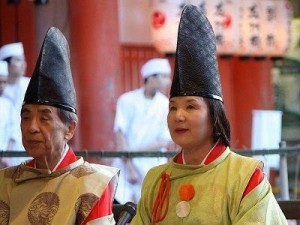 Shintō Priest and Priestess Shintō |
| Shinbutsu-shūgō: Syncretism of Shintō and Buddhism When Buddhism was introduced through China in the late Asuka period (6th century), rather than discard the old belief system the Japanese tried to reconcile it with the new, assuming both were true. As a consequence, Buddhist temples were attached to local Shintō shrines (神社 jinja) and vice versa and devoted to both Shintō gods and Buddha. The local religion and foreign Buddhism never quite fused, but remained however inextricably linked all the way to the present day, always interacting. The depth of the resulting influence of Buddhism on local religious beliefs can be seen for example in the fact that much of Shintō’s conceptual vocabulary and even the types of Shinto shrines today, with a large worship hall and religious images, are themselves of Buddhist origin. The formal separation of Buddhism from Shintō took place only as recently as the end of the 19th century, and in many ways the blending of the two still continues. (Source & More Information: Wikipedia: Shinbutsu-shūgō) |
| Torii Torii (鳥居; literally “bird’s perch”) is a traditional Japanese gate most commonly found at the entrance of or within a Shintō shrine, where it symbolically marks the transition from the profane to the sacred. They are however a common sight at Japanese Buddhist temples too, where they stand at the entrance of the temple’s own shrine, called chinjūsha (鎮守社) and are usually very small. Torii is one of the example of the amalgamation of Shintō and Buddhism you can see in Japan.The origins of the torii are unknown and there are several different theories on the subject, none of which has gained universal acceptance. Because the use of symbolic gates is widespread in Asia, such structures can be found for example in India, China, Thailand, Korea, and within Nicobarese and Shompen villages, historians believe they may be an imported tradition. They may, for example, have originated in India from the torana gates in the monastery of Sanchi in central India. According to this theory, the torana was adopted by Shingon-shū Buddhism school founder Kūkai, who used it to demarcate the sacred space used for a ceremony. The hypothesis arose in the 19th and 20th centuries due to similarities in structure and name between the two gates. Linguistic and historical objections have now emerged, but no conclusion has yet been reached. (Source & More Information: Wikipedia: Torii) |
Japanese Buddhist Sects
Japanese Buddhist branches are described as “十三宗五十六派 (jūsanshū gojūroppa),” which refers to thirteen Buddhist schools and fifty-six sects. In addition, several new religions have been established after WWII, such as Soka-gakkai, which developed from the Nichiren-shū schools. Following is an introduction to the eight major traditional schools in Japan.
Hossō-shū (法相宗)Hossō-shū is a Chinese Buddhist sects established by the Chinese monk Genjō (Xuanzang / Hieun Tsang), whose pilgrimage to India is well known through the book Journey to the West. The Japanese monk Dōshō traveled to China as a member of the Japanese missions to the Tang court in 653 AD and studied under the guidance of Genjō. He established the Buddhist temple Gangō-ji and became a priest after returning from China. Gangō-ji was one of the Seven Great Temples in Nara, Japan, and produced many great priests. During the Nara Period [710 to 794AD], it was one of the greatest temples, comparable to Tōdai-ji and Kōfuku-ji, but it fell into decline. Now, Kōfuku-ji and Yakushi-ji work as the two main branch temples of the Hosshō-shū. Hosshō-shū is related to Yogācāra (literally means “yoga practice” and “one whose practice is yoga”). In the Japanese teaching known as Yuishiki (唯識; literally means “consciousness only”), our understanding of reality comes from our own mind rather then actual empirical experience. This idea is the core teaching of Hossō-shū. Gangō-ji (World Heritage Site) |
|
Tendai-shū (天台宗)During the Heian Period [794-1185 AD] a Japanese monk named Saichō traveled to China as a member of the Japanese missions to Tang Chin in 804 AD. He learned the various teachings at the Tendai Mountain, among the holy sites of Mahāyāna Buddhism, and established Tendai-shū after coming back from China. His teachings were adapted in the Hokkekyō (法華経; Sanskrit: Saddharma Pundarīka Sūtra), religious precepts, Zen-shū, and Esoteric Buddhism, and these became the central part of Kamakura Buddhism. Kamakura Buddhism represents a revolution in Buddhism in Japan which started around the middle of 12th century. The new Buddhist schools established in Kamakura teach that even ordinary people (Sanskrit: Upāsaka or Upāsikā) can be saved if they strongly believe the teachings. Many founders of the new Kamakura Buddhist schools learned their practice at Enryaku-ji on Mount Hiei. |
|
Shingon-shū(真言宗)Shingon-shū is one of the few surviving Esoteric Buddhist sects in East Asia. A Japanese monk named Kūkai traveled to China with the monk Saichō, the founder of Tendai-shū, and visited the Chinese monk Eika (Huiguo), with whom he studied the Esoteric Buddhist tradition imported from India. After coming back to Japan, Kūkai began teaching the ideas of Esoteric Buddhism at Tō-ji and Kōyasan Kongūbu-ji and established Shingon-shū. There are now twenty branches of Shingon-shū. Koyasan Kongōbu-ji (World Heritage Site) |
|
|
|
Jōdo-shū(浄土宗)Jōdo-shū was established by a monk named Hōnen [1133-1212 AD], who studied Tendai-shū at Hieizan during the Kamakura Period [1185-1333 AD]. It is regarded as one of the new Kamakura Buddhist schools. The teaching is that everyone who says “Namu Amida Butsu (Sanskrit: Namo Amitābhāya; literally means “I go to the Amitābhāya for refuge”)” can reach the “Pure Land” (浄土 jōdo). This teaching spread rapidly and was accepted by many who sought salvation. During the Edo Period [1603-1868 AD], the rulers of the country, the Tokugawa shōguns, were patrons of and protected Jōdo-shū. Zōjō-ji located in the central Tokyo is known as the Tokugawa shōgun’ bodai-ji (bodhi temple), a temple which tales care care of a family’s dead, giving them burial and performing ceremonies in their soul’s favor. |
|
Jōdo Shin-shū (浄土真宗) or Shin-shū(真宗)Jōdo Shin-shū, or also known as Shin-shū, was established by Shinran [1173-1263 AD], a disciple of Hōnen who established Jōdo-shū during the Kamakura Period. Jōdo Shin-shū over several centuries grew into one of the largest and most influential schools of Japanese Buddhism, a position it maintains today. The two main denominations are Hongan-ji and Ōtani. Nishi Hongan-ji (West Hongan-ji) is the headquarters of the Hongan-ji sect, and Higashi Hongan-ji (East Hongan-ji) is the headquarters of the Ōtani sect today. |
|
|
|
Nichiren-shū(日蓮宗)Nichiren-shū was established by the monk Nichiren, who spread the worship of Hokkekyō (法華経; Sanskrit: Saddharma Pundarīka Sūtra), the Lotus Sūtra, which is one of the most popular and influential Mahāyāna sūtras. Nichiren taught that Hokkekyō is the most sacred sutra. Through chanting “Namu Myō Hōrengekyō (literally means “I go to the Hokkekyō for refuge”)” Nichiren tried to achieve peace in the present world. |
|
Rinzai-shū(臨済宗)Zen, which originates from the meditation practice called Dhyāna or Jhāna in Hinduism, Buddhism and Jainism, was introduced in China during 6th century by the Indian monk Bodhi Dharma. The Japanese monk Eisai [1141-1215 AD], the founder of Rinzai-shū, completed his study of Tendai-shū at Enraku-ji, and twice traveled to China during the Song dynasty [960-1279 AD] to study Zen. He established temples in Kyushu Island after his return. Between the end of the Kamakura Period [1185-1333 AD] and the beginning of the Muromachi Period [1336-1467AD], Rinzai-shū was protected by Japan’s rulers and reached the height of its prosperity. Rinzai-shū influenced architecture, gardening, literature and other arts and created the Zen culture which often even now represents the image of Japan. There are fifteen branches of Rinzai-shū, and five main temples in Kyōto and Kamakura are particularly well known. Tenryu-ji (World Heritage Site) |
|
|
|
Sōtō-shū(曹洞宗)Along with Rinzai-shū, Sōtō-shū is a Japanese Zen sect rooted to the teaching by Bodhi Dharma. The Japanese monk Dōgen Zenji [1200-1253 AD] founded Eihei-ji, the main temple of Sōtō-shū, in present-day Fukui Prefecture after his study in China. The characteristic of Sōtō-shū teaching is strict practices such as zazen. Like Rinzai-shū, Sōtō-shū was protected by the rulers of the period and developed into one of the major sects of Japanese Buddhism. Shōbōgenzō (Treasure of the True Dharma Eye), written by Dōgen in the thirteenth century, is among the major sources of Japanese Buddhist philosophy. The German philosopher Martin Heidgger was among many European philosophers who were interested in Dōgen’s philosophy. Several Japanese scholars believed that Heidgger wrote his masterpiece Being and Time inspired by the ideas of Shōbōgenzō. Eihei-ji |
|
|
|
|


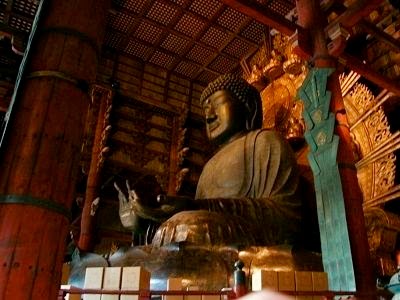


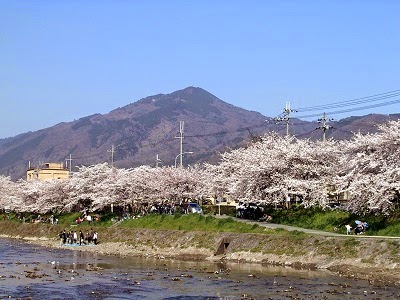



![Higashi Hongan-ji [1602 AD]](http://japan.saray.co.jp/wp-content/uploads/2015/04/higashihonganji-300x225.jpg)
![Nishi Hongan-ji [1602 AD]](http://japan.saray.co.jp/wp-content/uploads/2015/04/nishihonganji-300x225.jpg)
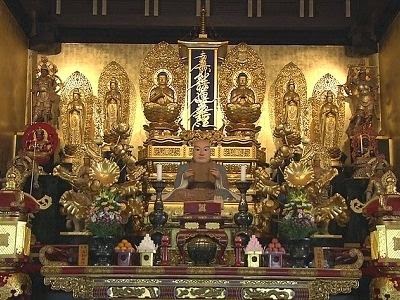

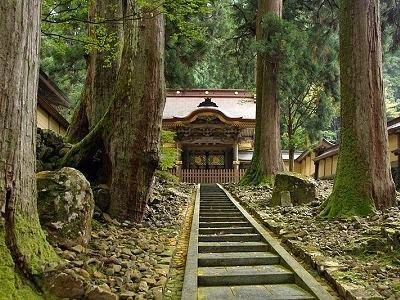
![Dōgen [1200-1253 AD]](http://japan.saray.co.jp/wp-content/uploads/2015/04/dogen.jpg)
